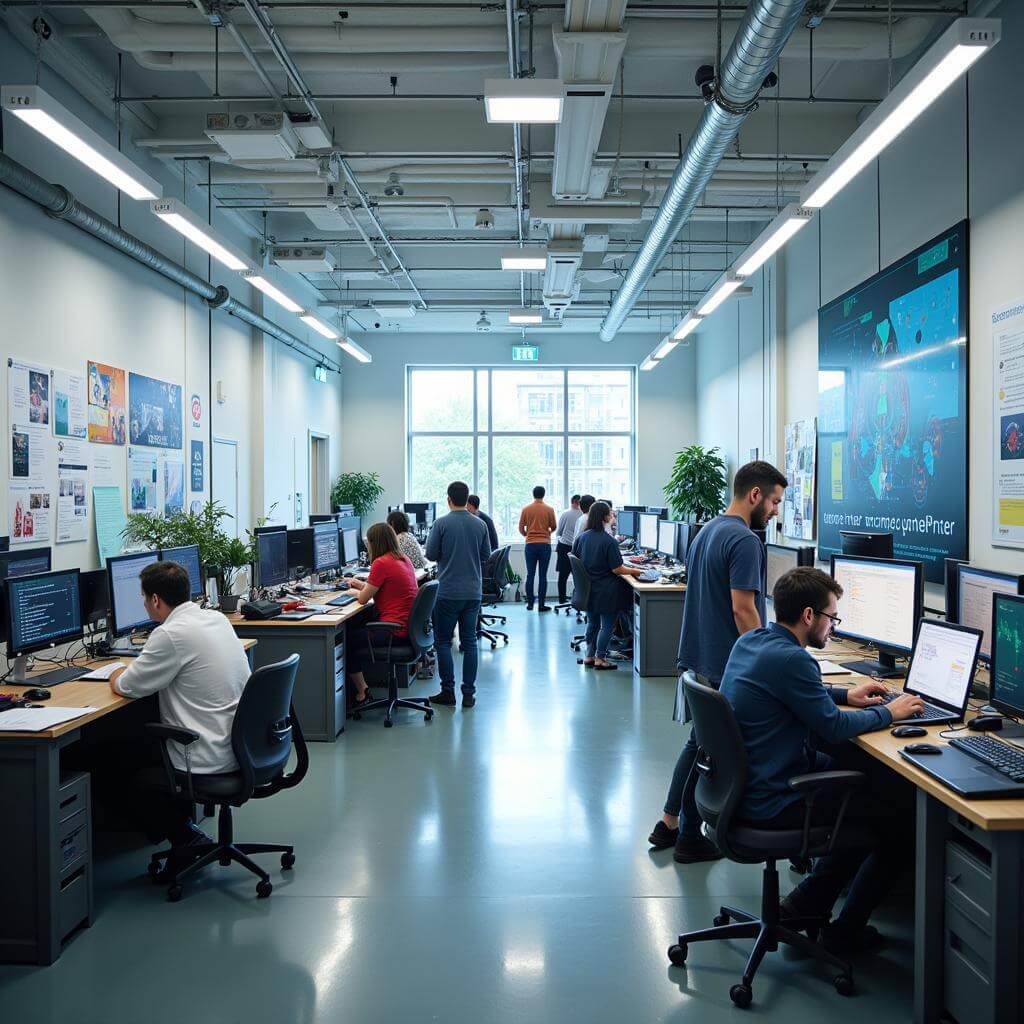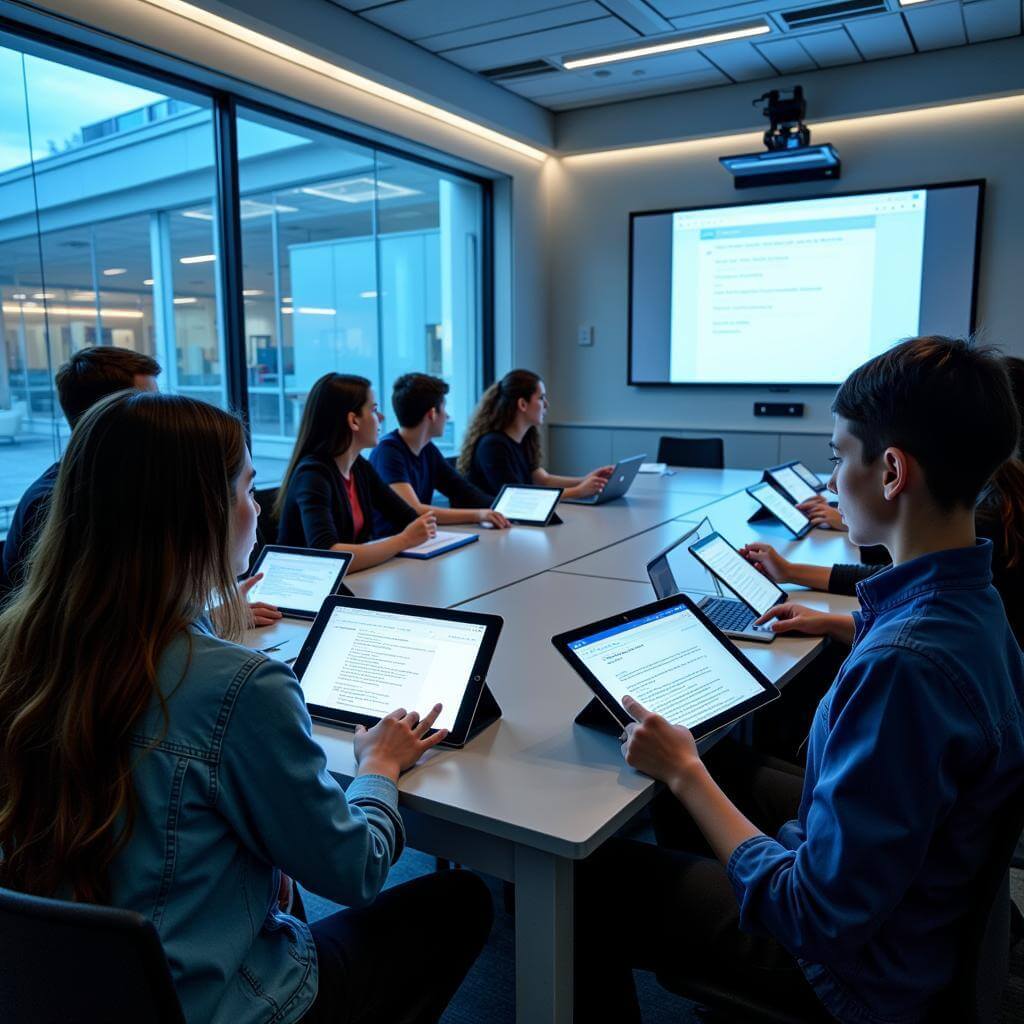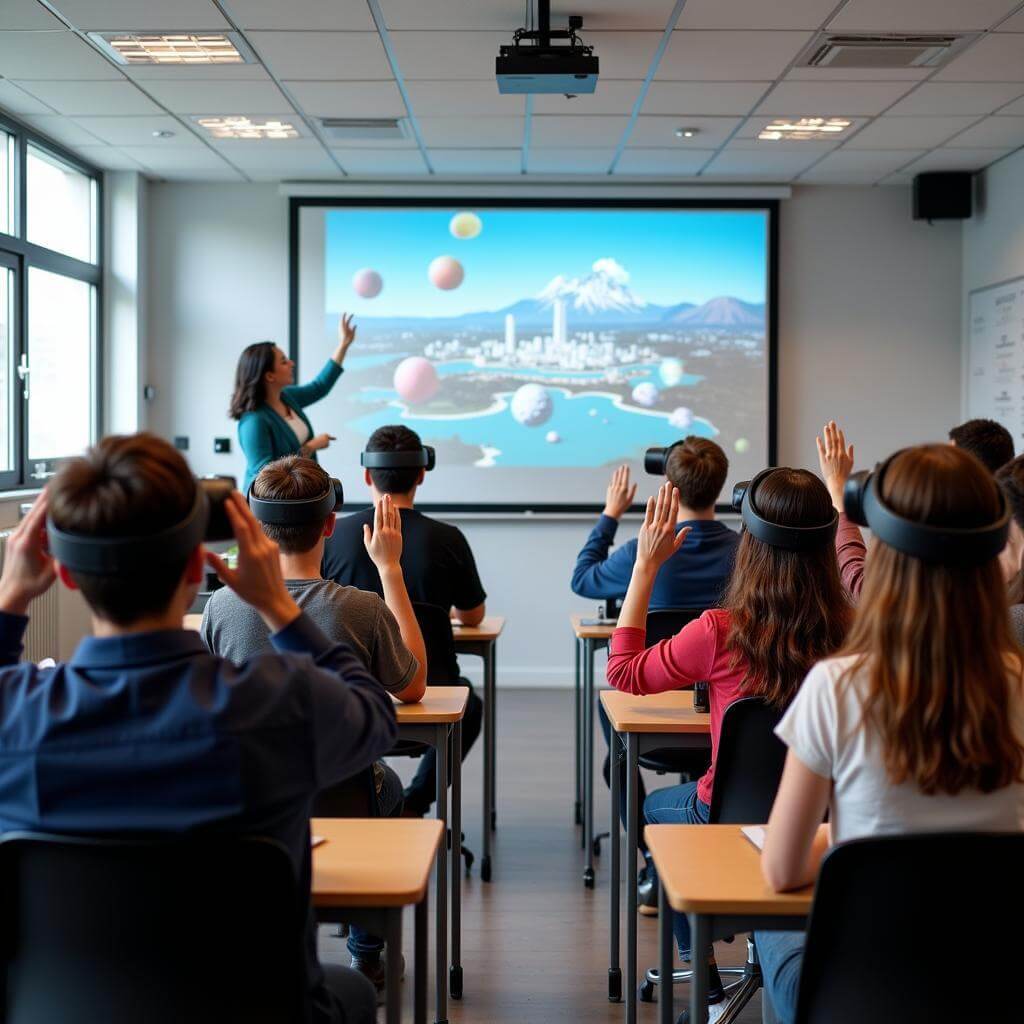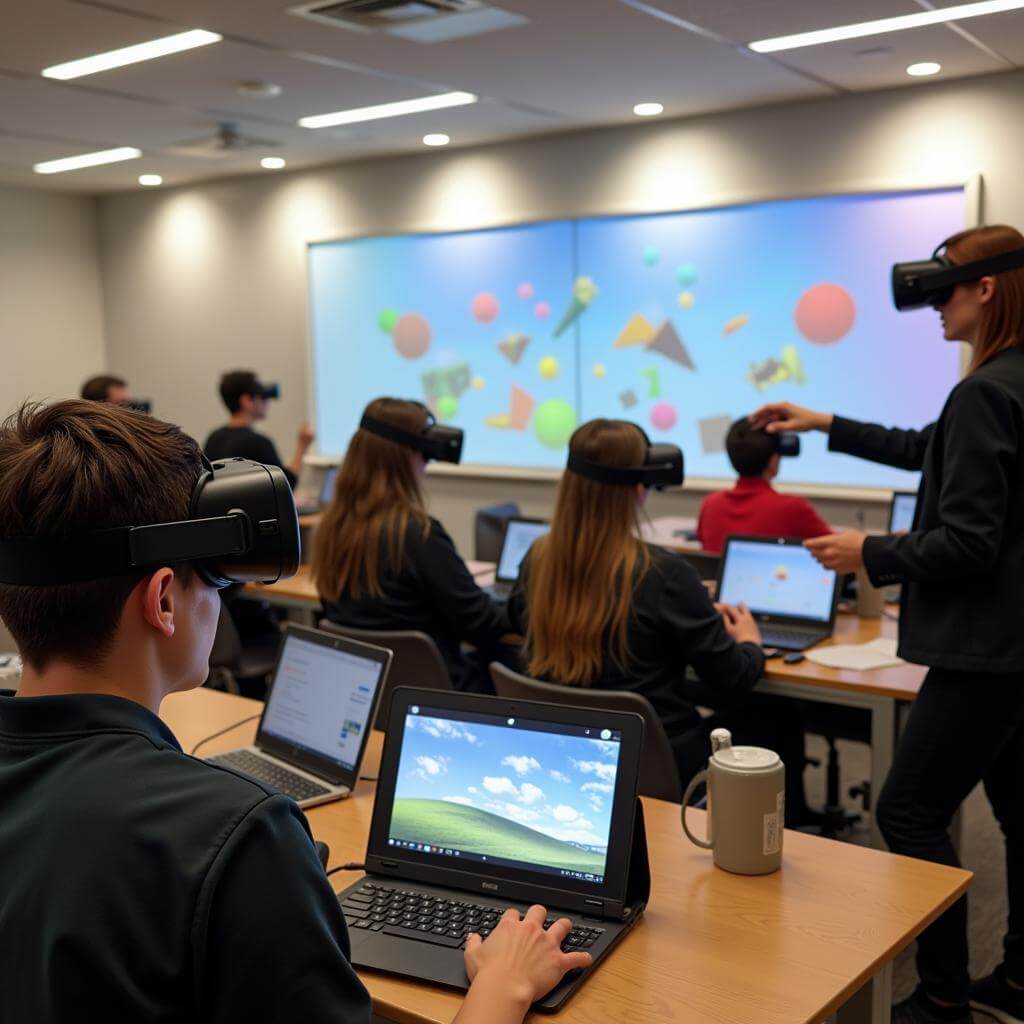The IELTS Reading test can be challenging, especially when it comes to complex topics like interdisciplinary approaches in student projects. This practice test will help you improve your skills and familiarize yourself with the format. Let’s dive into a full IELTS Reading test focused on this theme.
Passage 1 – Easy Text
The Rise of Interdisciplinary Learning
In recent years, educational institutions have increasingly embraced interdisciplinary approaches to learning. This shift recognizes that real-world problems rarely fit neatly into a single academic discipline. By encouraging students to draw connections between different fields of study, educators aim to foster more holistic and innovative thinking.
Interdisciplinary projects allow students to apply knowledge from various subjects to solve complex problems. For example, a project on sustainable urban planning might incorporate elements of environmental science, sociology, economics, and design. This approach not only deepens understanding of individual subjects but also develops critical thinking and adaptability skills highly valued in the modern workforce.
Student-led sustainability initiatives have become a prime example of interdisciplinary learning in action. These projects often require students to consider environmental, social, and economic factors, mirroring the complexities of real-world sustainability challenges.
One of the key benefits of interdisciplinary projects is the development of transferable skills. Students learn to synthesize information from multiple sources, communicate across disciplinary boundaries, and approach problems from diverse perspectives. These skills are increasingly important in a rapidly changing global economy where innovation often occurs at the intersection of different fields.
However, implementing effective interdisciplinary programs can be challenging. It requires careful coordination between teachers from different departments and a willingness to break down traditional subject silos. Additionally, assessment methods may need to be adapted to evaluate the unique outcomes of interdisciplinary work.
Despite these challenges, the potential benefits of interdisciplinary learning are significant. By preparing students to tackle complex, multifaceted problems, educational institutions are better equipping them for success in both higher education and their future careers.
Questions 1-5
Do the following statements agree with the information given in the passage? Write
TRUE if the statement agrees with the information
FALSE if the statement contradicts the information
NOT GIVEN if there is no information on this
- Interdisciplinary approaches to learning have become less popular in recent years.
- Sustainable urban planning projects may involve multiple academic disciplines.
- All educational institutions have successfully implemented interdisciplinary programs.
- Interdisciplinary projects help develop skills valued in the modern job market.
- Assessment methods for interdisciplinary work are always the same as traditional subject-based assessments.
Questions 6-10
Complete the sentences below. Choose NO MORE THAN TWO WORDS from the passage for each answer.
- Interdisciplinary projects aim to develop more __ and innovative thinking in students.
- Student-led sustainability initiatives often address environmental, social, and __ factors.
- The ability to __ information from multiple sources is a key skill developed through interdisciplinary projects.
- Implementing interdisciplinary programs requires breaking down traditional subject __.
- By tackling complex problems, students are better prepared for both higher education and future __.
Passage 2 – Medium Text
Bridging Disciplines: The Impact on Student Outcomes
The integration of interdisciplinary approaches in student projects has gained significant traction in educational institutions worldwide. This pedagogical shift is rooted in the recognition that complex global challenges require solutions that transcend traditional academic boundaries. As a result, curricula are being redesigned to foster connections between disparate fields of study, encouraging students to develop a more comprehensive understanding of intricate issues.
Research indicates that interdisciplinary projects can lead to enhanced cognitive flexibility and improved problem-solving skills among students. By engaging with multiple perspectives and methodologies, learners develop a more nuanced appreciation of the interconnectedness of knowledge. This approach aligns closely with the demands of the modern workplace, where the ability to synthesize information from diverse sources is increasingly valued.
Remote research projects in digital environments have further amplified the potential for interdisciplinary collaboration, allowing students to engage with peers and experts across geographical and disciplinary boundaries. These digital platforms facilitate the exchange of ideas and methodologies, fostering a global perspective on complex issues.
One notable example of successful interdisciplinary integration is the rise of environmental studies programs that combine elements of natural sciences, social sciences, and humanities. Students in these programs might analyze the ecological impact of urban development while simultaneously considering the socioeconomic factors that drive such development. This holistic approach enables a more comprehensive understanding of environmental challenges and potential solutions.
However, the implementation of interdisciplinary approaches is not without challenges. Academic institutions must navigate the logistical complexities of cross-departmental collaboration and address potential resistance from faculty members accustomed to more traditional, siloed approaches to education. Additionally, the development of appropriate assessment methods for interdisciplinary work remains an ongoing area of research and debate.
Despite these hurdles, the benefits of interdisciplinary education are increasingly recognized. Employers report that graduates with experience in cross-disciplinary projects demonstrate superior adaptability and innovation in the workplace. Furthermore, students engaged in interdisciplinary studies often report higher levels of engagement and motivation, as they see clear connections between their academic work and real-world applications.
As educational institutions continue to refine their approaches to interdisciplinary learning, the focus is increasingly on creating authentic learning experiences that mirror the complexity of real-world challenges. This may involve partnerships with industry leaders, community organizations, or government agencies to provide students with opportunities to apply their interdisciplinary knowledge to tangible problems.
The impact of interdisciplinary approaches extends beyond academic achievement. By fostering a more holistic worldview, these educational strategies aim to produce graduates who are not only well-versed in their chosen fields but also capable of navigating the complexities of a rapidly changing global landscape. As the boundaries between traditional disciplines continue to blur, the ability to think across these lines becomes not just an academic asset, but a vital skill for addressing the multifaceted challenges of the 21st century.
Questions 11-14
Choose the correct letter, A, B, C, or D.
-
According to the passage, interdisciplinary approaches in education are designed to:
A) Replace traditional subject-based learning entirely
B) Focus solely on environmental studies
C) Address complex global challenges
D) Simplify academic curricula -
The text suggests that interdisciplinary projects can lead to:
A) Decreased student engagement
B) Improved problem-solving skills
C) Lower academic achievement
D) Reduced workplace readiness -
What challenge is mentioned in implementing interdisciplinary approaches?
A) Lack of student interest
B) Insufficient funding
C) Resistance from some faculty members
D) Absence of digital platforms -
According to the passage, employers value graduates with interdisciplinary experience because they demonstrate:
A) Higher academic grades
B) Better adaptability and innovation
C) More specialized knowledge
D) Stronger loyalty to the company
Questions 15-19
Complete the summary below. Choose NO MORE THAN TWO WORDS from the passage for each answer.
Interdisciplinary approaches in education aim to develop students’ (15) __ flexibility and problem-solving abilities. These approaches often utilize (16) __ platforms to facilitate collaboration across different fields. Environmental studies programs are cited as an example, combining (17) __, social sciences, and humanities. While there are challenges in implementation, including the need for new (18) __ methods, the benefits are significant. Students engaged in interdisciplinary studies often report higher levels of (19) __ and motivation in their academic work.
Question 20
Choose the correct letter, A, B, C, or D.
- The main purpose of the final paragraph is to:
A) Criticize traditional educational methods
B) Highlight the limitations of interdisciplinary approaches
C) Emphasize the broader impact of interdisciplinary education
D) Predict future trends in global job markets
Passage 3 – Hard Text
The Paradigm Shift: Interdisciplinary Approaches Reshaping Academic Landscapes
The advent of interdisciplinary approaches in academia represents a paradigm shift that is fundamentally altering the landscape of higher education and research. This transformation is not merely a superficial change in curriculum design but a profound reconceptualization of how knowledge is created, disseminated, and applied. The impetus for this shift stems from the recognition that the most pressing challenges facing humanity—climate change, global health crises, economic inequality—are inherently complex and multifaceted, defying simple, discipline-specific solutions.
The epistemological foundations of interdisciplinary studies challenge the traditional notion of knowledge as compartmentalized into discrete academic disciplines. Instead, it posits that the boundaries between fields are often artificial constructs that can impede comprehensive understanding and innovative problem-solving. This perspective aligns with contemporary theories of knowledge construction, which emphasize the interconnectedness of ideas and the importance of context in understanding complex phenomena.
The impact of climate education on student activism exemplifies the potency of interdisciplinary approaches. By integrating insights from climatology, economics, politics, and sociology, students gain a holistic understanding of climate change that transcends purely scientific explanations. This comprehensive grasp often catalyzes informed activism, demonstrating how interdisciplinary education can foster engaged citizenship and real-world impact.
The implementation of interdisciplinary approaches in student projects necessitates a fundamental reevaluation of pedagogical methodologies. Traditional lecture-based instruction, while efficient for transmitting discipline-specific knowledge, is often inadequate for fostering the integrative thinking required in interdisciplinary work. Instead, problem-based learning, collaborative projects, and experiential education have emerged as more effective strategies. These methods not only facilitate the synthesis of knowledge across disciplines but also develop crucial metacognitive skills that enable students to navigate the complexities of interdisciplinary inquiry.
How student portfolios are being used in higher education reflects this shift towards more holistic and integrative assessment methods. Portfolios allow students to showcase projects that demonstrate their ability to synthesize knowledge from multiple disciplines, providing a more nuanced evaluation of their academic growth and potential.
The proliferation of interdisciplinary approaches has significant implications for the structure and organization of academic institutions. Traditional departmental silos are being replaced by more fluid, problem-focused research centers and educational programs. This reorganization facilitates cross-pollination of ideas and methodologies, fostering innovation at the intersections of disciplines. However, it also presents challenges in terms of resource allocation, faculty evaluation, and institutional governance.
 Researchers collaborating in interdisciplinary center
Researchers collaborating in interdisciplinary center
Critics of interdisciplinary approaches argue that they may lead to a dilution of disciplinary expertise, potentially compromising the depth of knowledge in specific fields. This concern underscores the need for a balanced approach that maintains disciplinary rigor while fostering interdisciplinary collaboration. Proponents counter that interdisciplinary work often leads to deeper insights within individual disciplines by introducing novel perspectives and methodologies.
The impact of interdisciplinary approaches extends beyond academia into the realm of innovation and economic development. The most groundbreaking technological advancements often emerge at the confluence of multiple disciplines. For instance, the field of bioinformatics, which combines biology, computer science, and statistics, has revolutionized genomic research and personalized medicine. Similarly, the integration of psychology and economics in behavioral economics has transformed our understanding of decision-making processes, with far-reaching implications for public policy and business strategy.
Sustainability education through community projects represents another frontier where interdisciplinary approaches are yielding tangible benefits. By engaging students in projects that address local sustainability challenges, educators can demonstrate the real-world applicability of interdisciplinary thinking while fostering community engagement and social responsibility.
As interdisciplinary approaches continue to gain traction, they are reshaping not only educational curricula but also the very nature of academic inquiry and knowledge production. This evolution reflects a broader societal shift towards more integrated, systems-level thinking in addressing global challenges. The success of this paradigm shift will depend on the ability of academic institutions to adapt their structures, incentives, and cultures to support truly collaborative and boundary-spanning work.
The future of interdisciplinary approaches in academia is likely to be characterized by even greater integration of technology, particularly in facilitating virtual collaboration across geographical and disciplinary boundaries. Artificial intelligence and machine learning algorithms may play an increasingly important role in identifying novel connections between disparate fields of study, potentially accelerating the pace of interdisciplinary discovery.
In conclusion, the influence of interdisciplinary approaches in student projects and broader academic endeavors represents a fundamental reimagining of the purpose and practice of higher education. By fostering integrative thinking, collaborative problem-solving, and a more holistic understanding of complex issues, these approaches are equipping the next generation of scholars and professionals with the tools needed to address the multifaceted challenges of our rapidly evolving world.
Questions 21-26
Complete the sentences below. Choose NO MORE THAN TWO WORDS from the passage for each answer.
- The shift towards interdisciplinary approaches in academia is described as a __ shift.
- Interdisciplinary studies challenge the idea that knowledge is divided into __ academic disciplines.
- Problem-based learning and collaborative projects help develop important __ skills.
- The reorganization of academic institutions to support interdisciplinary work presents challenges in __ allocation.
- Critics argue that interdisciplinary approaches may lead to a __ of disciplinary expertise.
- The field of __, which combines multiple disciplines, has revolutionized genomic research.
Questions 27-32
Do the following statements agree with the claims of the writer in the reading passage?
Write
YES if the statement agrees with the claims of the writer
NO if the statement contradicts the claims of the writer
NOT GIVEN if it is impossible to say what the writer thinks about this
- Interdisciplinary approaches are only relevant to scientific fields.
- Traditional lecture-based instruction is the most effective method for interdisciplinary learning.
- The restructuring of academic institutions to support interdisciplinary work is without challenges.
- Interdisciplinary work can lead to deeper insights within individual disciplines.
- The impact of interdisciplinary approaches is limited to academia and does not affect industry.
- Technology will play an increasing role in facilitating interdisciplinary collaboration in the future.
Questions 33-35
Choose the correct letter, A, B, C, or D.
-
According to the passage, the main reason for the shift towards interdisciplinary approaches is:
A) To simplify academic curricula
B) To address complex global challenges
C) To reduce the cost of education
D) To increase student enrollment -
The passage suggests that student portfolios in higher education:
A) Are becoming obsolete
B) Only focus on discipline-specific achievements
C) Provide a more comprehensive evaluation of student abilities
D) Are too difficult to assess fairly -
The author’s attitude towards the future of interdisciplinary approaches can be described as:
A) Highly skeptical
B) Cautiously optimistic
C) Completely neutral
D) Overwhelmingly negative
Answer Key
Passage 1
- FALSE
- TRUE
- NOT GIVEN
- TRUE
- FALSE
- holistic
- economic
- synthesize
- silos
- careers
Passage 2
-
C
-
B
-
C
-
B
-
cognitive
-
digital
-
natural sciences
-
assessment
-
engagement
-
C
Passage 3
- paradigm
- discrete
- metacognitive
- resource
- dilution
- bioinformatics
- NO
- NO
- NO
- YES
- NO
- YES
- B
- C
- B
This comprehensive IELTS Reading practice test focused on “The influence of interdisciplinary approaches in student projects” provides a thorough examination of your reading comprehension skills. Remember to practice time management and develop strategies for quickly identifying key information in complex texts. Good luck with your IELTS preparation!


